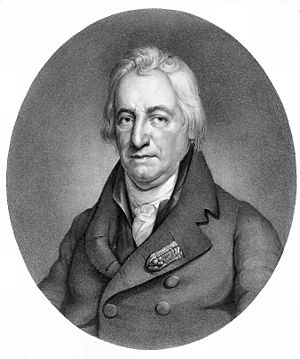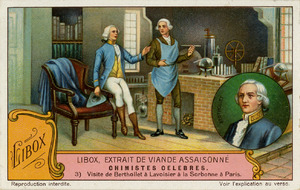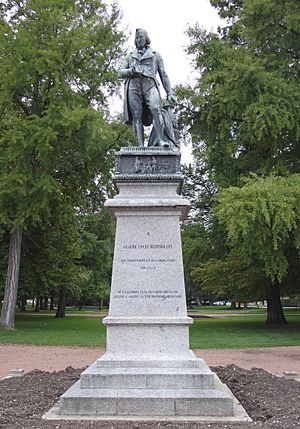Claude Louis Berthollet facts for kids
Quick facts for kids
Claude Louis Berthollet
|
|
|---|---|
 |
|
| Born | 9 December 1748 Talloires, Duchy of Savoy, Kingdom of Sardinia
|
| Died | 6 November 1822 (aged 73) Arcueil, France
|
| Nationality | Savoyard-French |
| Alma mater | Chambéry, Turin |
| Scientific career | |
| Fields | Chemistry |
| Institutions | Academy of Science |
Claude Louis Berthollet (born December 9, 1748 – died November 6, 1822) was an important chemist from Savoy, France. He became a high-ranking official in the French government in 1804.
Berthollet is famous for his ideas about how chemical reactions can go both ways and reach a balance. He also helped create the way we name chemicals today. In a practical sense, he was the first to show how chlorine gas could bleach things. He also developed the first modern liquid bleach.
Contents
About Claude Louis Berthollet
Claude Louis Berthollet was born in Talloires, near Annecy, in 1749. This area was part of the Duchy of Savoy at the time.
He began his studies in Chambéry and then in Turin, where he became a doctor. His amazing new discoveries in chemistry quickly made him a member of the Academy of Science in 1780.
Berthollet worked with other scientists, including Antoine Lavoisier. Together, they created a system for naming chemical compounds. This system is still used today as the basis for modern chemical names.
He also studied dyes and bleaches. In 1785, he was the first to use chlorine gas as a bleach for businesses. In 1789, he made the first modern liquid bleach in his lab in Paris. He did this by passing chlorine gas through a solution of sodium carbonate. The liquid he made was called "Eau de Javel" (Javel water). It was a weak solution of sodium hypochlorite. He also discovered another strong chlorine bleach, potassium chlorate, which is sometimes called Berthollet's Salt.
In 1785, Berthollet was the first to figure out what elements make up the gas ammonia.
He was also one of the first chemists to understand reversible reactions. These are reactions that can go in both directions. This led to the idea of chemical equilibrium, where reactions reach a balance.
Berthollet had a long discussion with another French chemist, Joseph Proust. They disagreed about the law of definite proportions. Proust believed that chemical compounds always have a fixed ratio of their elements. Berthollet thought this ratio could change depending on how much of each ingredient you started with.
Proust proved his idea with careful measurements. However, Berthollet's influence meant his theory was not immediately accepted. Later, it was found that Berthollet was not entirely wrong. There are some compounds that do not follow the law of definite proportions. These are called berthollides in his honor.
Berthollet was one of several scientists who traveled with Napoleon to Egypt. He was part of the science and natural history group of the Institut d'Égypte.
Awards and Recognitions
In April 1789, Berthollet was chosen as a Fellow of the Royal Society of London. In 1801, he became a foreign member of the Royal Swedish Academy of Sciences.
In 1809, Berthollet was elected a member of the Royal Institute of the Netherlands. This group later became the Royal Netherlands Academy of Arts and Sciences. He was also made an Honorary Fellow of the Royal Society of Edinburgh in 1820. In 1822, he became a Foreign Honorary Member of the American Academy of Arts and Sciences.
In 2015, Berthollet's 1788 book, Méthode de Nomenclature Chimique, received an award. This book was written with his colleagues Antoine Lavoisier, Louis Bernard Guyton de Morveau, and Antoine François, comte de Fourcroy. It was honored by the American Chemical Society for being a "Chemical Breakthrough."
A high school in Annecy, France, is named after him: Lycée Claude Louis Berthollet.
Personal Life
Berthollet married Marie Marguerite Baur in 1788. He passed away in Arcueil, France, in 1822.
Images for kids
See also
 In Spanish: Claude Louis Berthollet para niños
In Spanish: Claude Louis Berthollet para niños
- Society of the Friends of Truth






